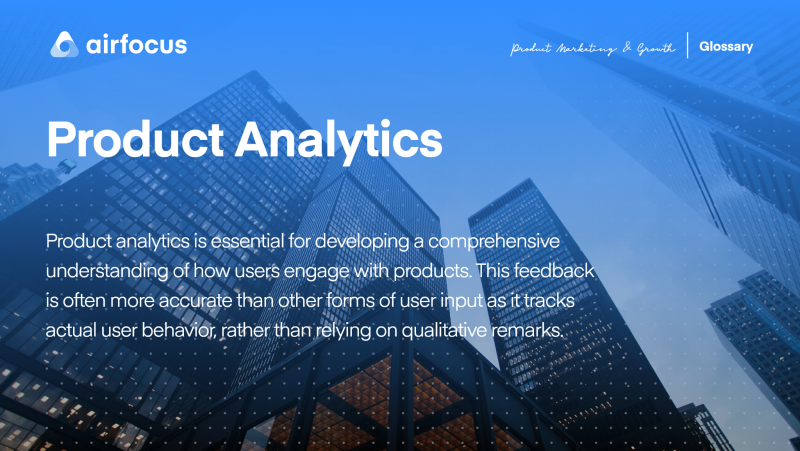Product Analytics
What Is Product Analytics
Definition of Product Analytics
As a term, product analytics concerns the gathering and application of key data, to determine how and why users engage with a digital product. Companies can take advantage of these insights to identify gaps in their user/customer experience, recognize opportunities for growth, and improve their products based on accurate research.
Product analytics empowers designers, developers, product managers, and other key figures to understand which the most popular features of a product are, the length of time it takes to complete actions, how problems disrupt engagement, and more.
Why is product analytics important
Product analytics is crucial because it shows companies how customers engage with their technology products in a real, everyday way.
Businesses may also choose to gather feedback through surveys or conversations, but these methods rely on users’ memories, honesty and self-awareness. Product analytics, on the other hand, tracks real-time behavior and therefore cannot be disputed.
What’s more, if individuals choose to not complete a satisfaction questionnaire, or hold back from sharing their experience in full, a company might be unaware of real issues putting the user experience at risk.
So this is where product analytics come in.
Implementing product analytics provides product teams with the tools they need to gain visibility and explore their users’ behavior accurately. They can analyze the ways in which users gain value from the product, which features see the highest usage rates, usage frequency, identify the functions which cause confusion or usability problems, and more.
Product designers and developers can leverage this data when working on ongoing improvements or new products. They will know which elements are most beneficial to the core audience and which can be removed or left out altogether.
When product analytics is applied properly, the offer will become more relevant and valuable to its users, helping to increase retention and (ideally) ROI. Companies can gain a more competitive advantage by delivering a customer-focused, data-driven product tailored to user needs.
Without product analytics, teams are left to make guesses and assumptions about what their users want. And that’s no good. You can’t tell audiences what they want. You have to listen, watch, adapt, and keep refining products to be the ideal solution for the target user.
How is product analytics applied
Companies planning to put product analytics into action should follow the following steps to get the most value out of the process:
Outlining goals
To start with, product teams should be clear on the reasons for capturing specific types of data.
What are the business objectives driving these decisions? What will the data gathered tell you about the product’s performance, its audience, and potential changes in the future?
Creating a list of product analytics objectives prevents teams investing money into the process without knowing what they’re trying to learn. And that reduces the risk of wasted resources, not to mention lost time.
Focusing on data that offers real worth is more likely to lead to valuable adjustments. For example, you may find that a large proportion of your user base is struggling to navigate a product’s dashboard as quickly and efficiently as they expect.
This can slow their entire workflow down, cause them to feel frustrated, and inspire them to look elsewhere for options that better suit their requirements.
Seeing this confusion in action, product teams quickly know where to focus their energies to improve the user experience and increase retention. If the designers, developers, and product managers continue unaware of this problem with the dashboard, usage rates could drop significantly without their knowing exactly why.
Tracking data in an accurate, organized way
Usually, data gathered through product analytics is segmented into events. A single event relates to one action a user takes with the product, such as sending an email, activating a feature, making a purchase, etc.
It’s vital to put a plan together so the product team knows which events are set to be tracked. This should be recorded in an easily-accessible file to create visibility for everyone involved. As a result, the team will have a clear guide to which steps play an important role in the user’s journey, from the moment they launch the product to the moment they close it.
Covering main events reduces the danger of missing how a user engages with the product in a small but important way. Even the slightest oversight could disrupt the user experience and the product’s commercial success.
You should only track events which create the opportunity to grow and improve the product, not because you’ve heard a competitor does so.
There should be a clear system in place for who does what with data after it’s been collected. At which point are stakeholders informed of problems and plans to solve them? Which developers are tasked with implementing changes, and why?
Think about these and similar questions to avoid confusion or oversights.
Finding the best tools
A number of product analytics tools are available, offering varying types of reports charting the user experience. Google Analytics, Mixpanel, Amplitude, and Kissmetrics are just a few options, but companies will likely need to sign up with multiple platforms to collate the full range of data they need.
There’s a wealth of information out there on each of these tools, catering to businesses targeting diverse audiences. Product teams should do their research to find those tools best suited to their goals and working processes.
Furthermore, the product analytics should integrate with your tools and/or sites properly for maximum impact. The way in which this works can vary, from a line of code to an SDK, but they have to be implemented effectively to gain the insights you’re looking for.
Again, do your research to discover which tools suit your time, budget, and resources best.

General FAQ

Glossary categories
Experience the new way of doing product management

Experience the new way of doing product management








